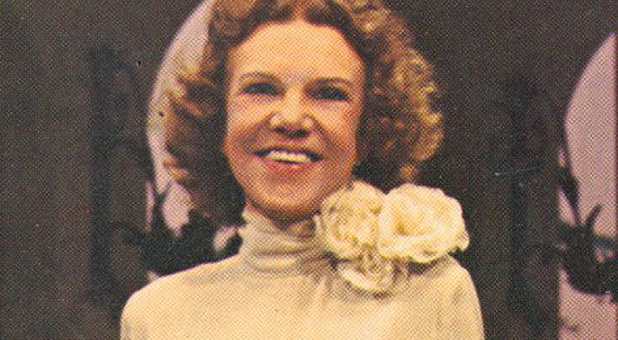Although many were praying for the sick in the charismatic renewal, perhaps the most prominent advocate for healing was Kathryn Kuhlman (1907-1976). During this era, she became “one of the best-known woman revivalists in America.”
When Kuhlman initially launched her ministry in the Pacific Northwest, she did not accentuate healing. Although occasionally ministering to the sick, Kuhlman was “chary about the propriety of healing services,” write Robert Krapohl and Charles Lippy. She “determined that she would not indulge in the sensationalism that was obvious in most healing revivals.”
Her reticence about healing changed in 1946, after some notable encounters. Kuhlman writes, according to Allen Spraggett:
“I was preaching in Franklin, Pennsylvania. One night my sermon was on the Holy Spirit. I hadn’t mentioned healing. But the next night, before I began to preach, a woman stood up and said, ‘Pardon me Miss Kuhlman, but I have a testimony to give. While you were preaching last night I had a strange sensation in my body, and I knew I had been healed. I knew it. Today I went to my doctor, and he confirmed that I was.’ As I recollect, the woman had had a tumor. And that was the beginning, the first of miracles.”
As people “began to claim deliverance from infirmities,” it shifted the trajectory of Kuhlman’s ministry. It wasn’t long before “attendance at her services mushroomed, and lines began to form at the close of her services as people sought prayers for healing,” write Robert Krapohl and Charles Lippy.
Kuhlman’s Methodology
As she traveled the United States, Kuhlman embraced a considerably different approach. Instead of following the calculating strategies of her peers, “Kathryn realized that simply by honoring the Holy Spirit and by being in God’s presence, healing could be released,” says Bill Johnson.
Researcher Candy Gunther Brown writes:
“Kuhlman intentionally distanced herself from the techniques of contemporary Voice of Healing evangelists, whom she faulted for showmanship and for blaming the sick when they were not cured. Kuhlman avoided the practices of distributing prayer cards or forming healing lines, although she encouraged people to combine their praying with fasting and to express their faith by action. She rarely prayed for individuals at all, instead creating an atmosphere of worship and faith in which people claimed to receive healings through the power of Holy Spirit.”
Kuhlman admitted that she had witnessed outrageous things in Pentecostal meetings. As one evangelist went through the mass of afflicted people, “the more seriously ill patients were steered out of the healing line to the ‘invalids’ tent’ away from the prying eyes of the public,” according to Jamie Buckingham. This approach naturally rubbed her the wrong way.
Kuhlman believed the greatest miracles transpired in worship as the Holy Spirit sovereignly moved through the auditorium. The “circus sideshow” and tent theatrics were unnecessary. She writes in I Believe in Miracles:
“I understood that night why there was no need for a healing line; no healing virtue in a card or a personality; no necessity for wild exhortations ‘to have faith.’ That was the beginning of this healing ministry which God has given me; strange to some because of the fact that hundreds have been healed just sitting quietly in the audience, without any demonstration whatsoever, and even without admonition. This is because the presence of the Holy Spirit has been in such abundance that by His presence alone, sick bodies are healed, even as people wait on the outside of the building for the doors to open.”
As she received fresh insight, she adjusted her meetings to better accommodate the Holy Spirit’s movement. Kuhlman notes, according to Allen Spraggett:
“When the power of the Spirit is there, miracles happen. Gradually, I began to understand The power, how it operates. I discovered that certain things brought the presence of the Holy Spirit. Praise, for instance. Just praising God— not asking for a single thing but just praising Him— always brings the power. It’s pleasing to the Lord. … You do not manipulate the Holy Spirit. The Holy Spirit is a person. He is not an ‘it.’ He is God. He is to be reverenced, to be worshiped. He is not to be presumed upon by anyone.”
Conventional methods for conducting crusades were cast aside as Kuhlman unhesitantly advanced in the subtle leadings of the Lord.
Testimonies in Kuhlman’s Meetings
Compelling reports of healings were abundant. Roberts Liardon suggests that “There were thousands upon thousands of miracles.”
In one exhilarating testimonial, Kathryn writes in Nothing Is Impossible With God that a woman who was afflicted with cancer shared the following:
“Miss Kuhlman was walking back and forth across the stage. She wasn’t screaming or yelling, as I had thought she would be. She wasn’t even preaching, just talking. She said, ‘I don’t want anyone to come up here on the stage until you have been healed.’ Amazing, I thought to myself. I had pictured her slapping people on the forehead, vibrating and shaking, screaming commands for the Lord to heal some poor wretch. It wasn’t that way, but people started coming forward, testifying that they had been healed while they were sitting in their seats.”
In the midst of the exuberant testimonies and worship, something amazing transpired. She writes:
“Something else happened. I discovered I couldn’t move my arms or legs. More surprising still, it didn’t bother me to sit there paralyzed. In fact, it was altogether a very wonderful feeling. Mom later told me that Miss Kuhlman said someone was being healed of cancer, but I didn’t hear it. As a matter of fact, I didn’t hear much of anything during this time. When the wonderful feeling passed, a new feeling, a conviction, took its place—a deep conviction that I no longer had cancer.”
A short time later, she went to the doctor, and he told her that the biopsy was entirely negative. They found no malignancy whatsoever. She writes that she questioned the doctor, saying, “I thought the first biopsy showed total malignancy.” He shrugged. “It did, but when you got in there, everything was fine. I don’t think you’re going to have any trouble at all.'”
There were remarkable accounts like this transpiring every time that Kuhlman held a crusade. Individuals were getting out wheelchairs, and lives were being restored. Providing a fascinating summary, Roberts Liardon writes:
“On one occasion, a five-year-old boy, crippled from birth, walked to Kathryn’s platform without assistance. On another, a woman, who had been crippled and confined to a wheelchair for twelve years walked to the platform without aid from her husband. A man from Philadelphia, who had received a pacemaker eight months earlier, felt intense pain in his chest after Kathryn laid hands upon him. Returning home, he found the scar gone from his chest where the pacemaker had been implanted, and he couldn’t tell if the pacemaker was functioning. Later, when the doctor took x-rays, he discovered the pacemaker was gone, and the man’s heart healed. It was common for tumors to dissolve, cancers to fall off, the blind to see and the deaf to hear. Migraine headaches were healed instantly. Even teeth were divinely filled. It would be impossible to list the miracles that the ministry of Kathryn Kuhlman witnessed! God alone knows.”
Kathryn Kuhlman, arguably became the most influential figure of the charismatic renewal, transforming a whole generation’s understanding of healing and crusade evangelism.

